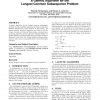Free Online Productivity Tools
i2Speak
i2Symbol
i2OCR
iTex2Img
iWeb2Print
iWeb2Shot
i2Type
iPdf2Split
iPdf2Merge
i2Bopomofo
i2Arabic
i2Style
i2Image
i2PDF
iLatex2Rtf
Sci2ools
GECCO
2006
Springer
2006
Springer
A genetic algorithm for the longest common subsequence problem
A genetic algorithm for the longest common subsequence problem encodes candidate sequences as binary strings that indicate subsequences of the shortest or first string. Its fitness function penalizes sequences not found in all the strings. In tests on 84 sets of three strings, a dynamic programming algorithm returns optimum solutions quickly on smaller instances and increasingly slowly on larger instances. Repeated trials of the GA always identify optimum subsequences, and it runs in reasonable times even on the largest instances. Categories and Subject Descriptors G.2.1 [Mathematics of Computing]: Discrete Mathematics--Combinatorics; I.2.8 [Problem Solving, Control Methods, and Search]: Heuristic Methods General Terms Algorithms Keywords Strings, longest common subsequence, genetic algorithm
GECCO 2006 | Genetic Algorithm | Longest Common Subsequence | Longest Common Subsequence Problem | Optimization |
Related Content
| Added | 23 Aug 2010 |
| Updated | 23 Aug 2010 |
| Type | Conference |
| Year | 2006 |
| Where | GECCO |
| Authors | Brenda Hinkemeyer, Bryant A. Julstrom |
Comments (0)

